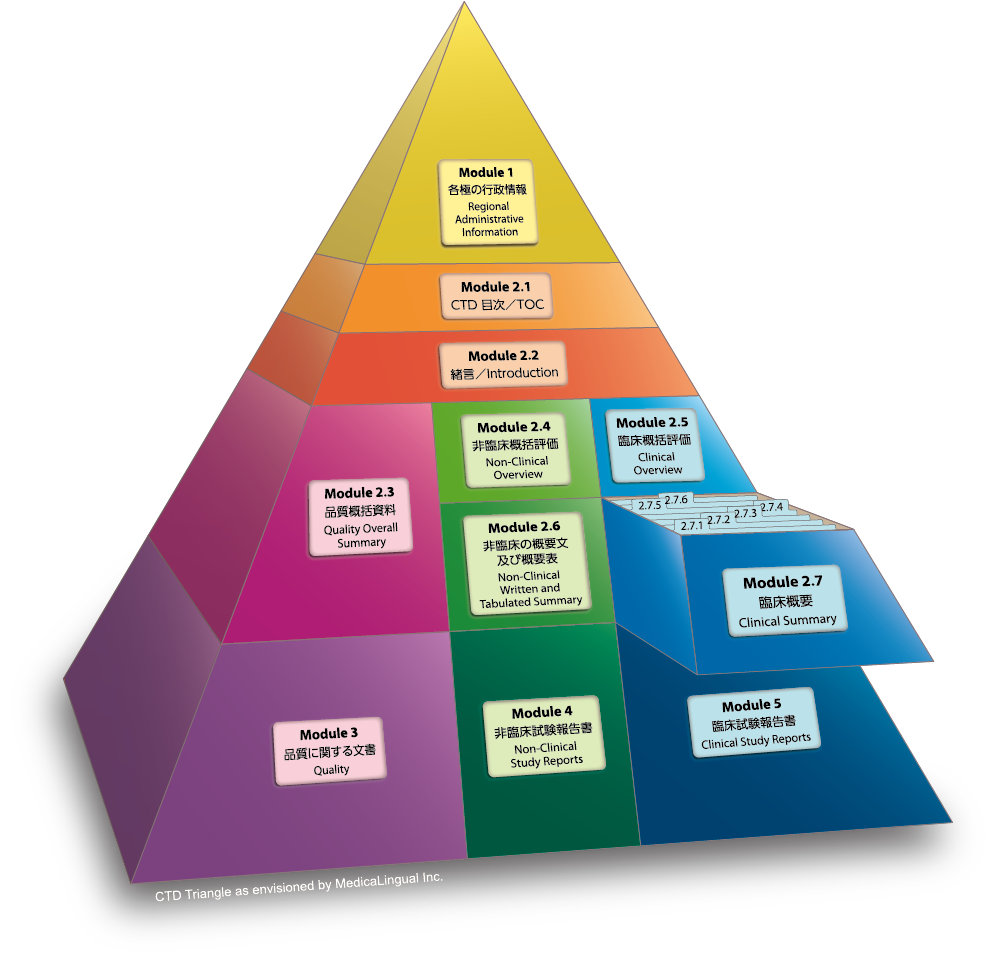
薬生薬審発0202第1号(平成29年2月2日)
ICH HARMONISED GUIDELINE- M4E(R2) – Dated 15 June 2016
Module 2.7 臨床概要
2.7.3 臨床的有効性の概要
Module 2.7 CLINICAL SUMMARY
2.7.3 Summary of Clinical Efficacy
2.7.3.3 全試験を通しての結果の比較と解析
第2.7.3.3項中のサブセクションでは、文章、図、表を適切に用い(第2.7.3項付録を参照)、当該医薬品の有効性を特徴づける全てのデータを要約すること。この要約には、最終的な結論を裏付けているかどうかにかかわりなく、全てのデータの解析結果が含まれていなければならず、従って、関連する試験が互いにどの程度結論を確立するうえで有用かどうかも考察すること。有効性に関するデータ間に重大な不整合があれば記載し、追加検討を要する事柄を明らかにすること。
2.7.3.3 Comparison and Analyses of Results Across Studies
Using text, figures, and tables as appropriate (see the section 2.7.3.6 Appendix), the subsections of 2.7.3.3 should summarise all available data that characterise the efficacy of the drug. This summary should include analyses of all data, irrespective of their support for the overall conclusion and should, therefore, discuss the extent to which the results of the relevant studies do or do not reinforce each other. Any major inconsistencies in the data regarding efficacy should be addressed and any areas needing further exploration should be identified.
本項における有効性に関する検討方法は通常二種類あり、一つは個々の試験結果の比較であり、もう一つは複数試験からのデータを併せた分析である。本項に記載できない詳細な検討結果は別途第5部第5.3.5.3項に添付すること。
The section will generally utilise two kinds of analyses: comparison of results of individual studies, and analysis of data combined from various studies. Details of analyses that are too extensive to be reported in a summary document should be presented in a separate report, to be placed in Module 5, Section 5.3.5.3.
さらに、添付文書中の用法・用量の内容を裏付ける第2.7.2項に含まれるデータ等の重要な科学的根拠を示すこと。対象となるデータとしては、推奨する用量及び投与間隔、個々の患者における用量調整、特別な患者集団における用量変更の必要性(小児、高齢者、肝障害、又は腎障害のある患者等)、用量-反応又は濃度-反応関係(PK/PD)等が含まれる。
This section should also cross-reference important evidence from section 2.7.2, such as data that support the dosage and administration section of the labelling. These data include dosage and dose interval recommended, evidence pertinent to individualisation of dosage and need for modifications of dosage for specific subgroups (e.g., paediatric or geriatric subjects, or subjects with hepatic or renal impairment), and data relevant to dose-response or concentration response (PK/PD) relationships.
2.7.3.3.1 試験対象集団
有効性を検討した全ての試験における被験者の人口統計学的及び他の基準値の特性を記載する。含むべき内容は以下のとおり。
- 被験者における疾患の特性(例:重症度、罹病期間)と前治療、選択/除外基準。
- 試験間又は試験グループ間における試験対象集団の基準値特性の差異。
- 主たる有効性の評価対象となった試験対象集団と市販後に使用が予想される患者集団との差異。
- 試験から脱落した患者の数、中止時期(治験期間中あるいは追跡期間中の試験日・来院時期)、投与中止理由についての評価。
表形式により試験対象集団を併記して比較することは有用と思われる。
2.7.3.3.1 Study Populations
The demographic and other baseline characteristics of patients across all efficacy studies should be described. The following should be included:
- the characteristics of the disease (e.g., severity, duration) and prior treatment in the study subjects, and study inclusion/exclusion criteria
- differences in baseline characteristics of the study populations in different studies or groups of studies.
- any differences between populations included in critical efficacy analyses and the overall patient population that would be expected to receive the drug when it is marketed should be noted.
- assessment of the number of patients who dropped out of the studies, time of withdrawal (a defined study day or visit during treatment or follow up period), and reasons for discontinuation.
Tabular presentations that combine and compare study populations across studies may be useful.
2.7.3.3.2 全有効性試験の結果の比較検討
ある特定の外国臨床データを新地域に外挿できるかどうかを検討するために実施した試験等、臨床的エンドポイントを用いたブリッジング試験(ICH E5を参照)に関する要約は、本項に記載すること。地域間における有効性データの類似性について検討した結果、又は新地域における有効性データの外挿を可能にする情報も本項にて要約する。これらの要約のため本項にサブセクションをおこしてもよい。
2.7.3.3.2 Comparison of Efficacy Results of all Studies
The results of any bridging studies using clinical endpoints, i.e., certain studies used to evaluate the ability to extrapolate certain types of foreign clinical data to the new region (see ICH E5), should be summarised in this section. An analysis of the similarity of efficacy in subjects between regions, as well as any other information that may support extrapolation of the efficacy data to the new region, should be summarised here. An independent subsection can be created to summarize these kinds of data.
結論が明確でない試験や否定的な試験も含め、有効性の評価を目的とした全ての試験の結果を要約し比較すること。エンドポイント、対照群、試験期間、統計解析方法、被験者集団、投与量等で重要な試験デザイン上の差異があれば明示すること。
The results from all studies designed to evaluate the drug’s efficacy should be summarised and compared, including studies with inconclusive or negative results. Important differences in study design such as endpoints, control group, study duration, statistical methods, patient population, and dose should be identified.
試験間の比較は、プライマリーエンドポイントとして事前に規定した項目に焦点を合わせて行うこと。しかし、プライマリーエンドポイントが試験間で共通でない場合や測定点が同一でない場合は、全ての試験に共通して測定された重要データを用いて比較することが有用であろう。経時的な結果が重要だと思われるのであれば、各試験における経時的な変化を図示してもよい。
Comparisons of results across studies should focus on pre-specified primary endpoints. However, when the primary endpoints involved different variables or time points in different efficacy studies, it may be useful to provide cross-study comparisons of important data elements that were obtained in all studies. If results over time are important, results of studies may be displayed in a figure that illustrates the change over time in each study.
治療効果に関する信頼区間を表示し、点推定値を解釈するための助けとすること。ベースラインからの変化量においてプラセボと治験薬との間に差が認められる場合、プラセボ群又は実薬対照群(用いた場合)を含む各々の治療群でのベースライン値と治療効果の大きさを、基本的には表形式で、あるいは文章に図を添付した形式で示すこと。実薬対照を用いた試験の目的が、同等性又は非劣性の証明にある場合、群間差の値や比率を信頼区間と共に示すこと。結果は、事前に定義した同等性又は非劣性の基準により評価し、その基準の理論的根拠と試験の分析感度を検討した根拠を示すこと(ICH E10を参照)
Confidence intervals for treatment effects should be given to aid in the interpretation of point estimates. If differences are shown between placebo and test drugs in the change from baseline, the baseline values and the magnitude of effect in all treatment groups, including placebo and active controls (if used), should generally be presented in the table or in text accompanying a figure. If the objective of an active control trial was to show equivalence or non-inferiority, the difference or the ratio of outcomes between treatments should be given with the confidence interval. The results should be evaluated by using the predefined criteria for defining equivalence or non-inferiority and the rationale for the criteria and support for the determination that the study (studies) had assay sensitivity should be provided (see ICH E10).
試験デザインが似ているにもかかわらず試験結果に重大な相違が認められた場合は、その違いを詳述し考察すること。また、相違に関係したと思われる要因を試験間で比較し示すこと。
Important differences in outcomes between studies with a similar design should be delineated and discussed. Cross-study comparisons of factors that may have contributed to differences in outcomes should be described.
メタアナリシスが実施されている場合、その解析がプロトコルに基づきなされたものか、試験後に実施されたものかを明確にすること。試験デザインの比較や試験対象集団の違い、あるいは有効性評価法の違いを記述して、結果や結論の類似性及び妥当性の評価ができるようにすること(ICH E9を参照)。メタアナリシスの方法や結果に関する詳細な説明は、通常、別の報告書として提出すること(第5部第5.3.5.3項)。
If a meta-analysis of the clinical studies is performed, it should be clear whether this analysis is conducted according to a predefined protocol or is a post hoc exercise. Any differences in trial designs or populations, or in efficacy measurements between trials should be described to allow assessment of the relevance and validity of the results and conclusions (See ICH E9). A detailed description of the methodology and results of the meta-analysis should generally be submitted in a separate report (section 5.3.5.3 of Module 5).
2.7.3.3.3 部分集団における結果の比較
本項では、特定の患者集団における有効性に関する個々の試験の結果又は全試験を通じての概括的な評価を要約すること。部分集団にて比較する目的は、対象となる全ての部分集団、特に、懸念される特別な理由がある部分集団で、主張する治療効果が一貫して得られているかどうかを示すことにある。比較をすることで、検討や考察をさらに必要とする有効性のバラツキを明らかにすることにもなるだろう。
2.7.3.3.3 Comparison of Results in Sub-populations
The results of individual studies or overview analyses of efficacy in specific populations should be summarised in this section. The purpose of these comparisons should be to show whether the claimed treatment effects are observed consistently across all relevant subpopulations, especially those where there are special reasons for concern. The comparisons may highlight apparent variations in efficacy that require further investigation and discussion.
ただし、こうした分析には限界もあることを認識しておくこと(ICH E9)。また、かかる比較は、特定の効能・効果の根拠そのものを生み出すためのものではなく、全体の結果が好ましくない状況下で有効性の根拠を補強するためのものでもないことに注意すること。
The limitations of such analyses, however, should be recognised (ICH E9), and it is important to note that their purpose is not to provide the basis for specific claims, nor to attempt to improve the evidence of efficacy in situations where the overall results are disappointing.
個々の試験における症例数が十分でない場合、複数の試験をまとめて分析を行い、有効性に影響する主要な人口統計学的特性(年齢、性別、人種)、事前に定めた又は関連する内因性/外因性要因(例:重症度、前治療、合併症、併用薬、飲酒、喫煙、体重)について評価すること。さらに、一般的に懸念される要因(例:高齢者)や当該医薬品の薬理作用から考えられる要因、又は開発の初期段階にて生じた特別な要因等も評価すること。申請適応症から小児も対象となり得る場合、小児における有効性を分析し記述すること。詳細な解析が実施された場合は、その報告書を第5部に添付し、要約をこの項に記載してよい。
Given the limited sample sizes in individual studies, analyses across multiple studies should be performed to evaluate effects of major demographic factors (age, sex, and race) and of other predefined or relevant intrinsic and extrinsic factors (e.g., disease severity, prior treatment, concomitant illness, concomitant drugs, alcohol, tobacco, and body weight) on efficacy. Factors of special interest may arise from general concerns (e.g., the elderly) or from specific issues that are related to the pharmacology of the drug or that have arisen during earlier drug development. Efficacy in the paediatric population should be routinely analysed in applications for a proposed indication that occurs in children. Depending on the data set, if extensive, detailed efficacy analyses are performed, they can be placed in Module 5, with the results of those analyses reported here.










